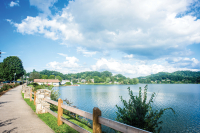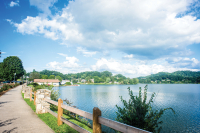The Naturalist's Corner
Spring in the watershed
The Town of Waynesville’s annual spring pilgrimage to the Waynesville Watershed will be Saturday, April 24. This one will be set up similar to last fall’s event with an early morning birding option. Those who want to look for early Neotropical migrants and lingering winter visitors should meet at the treatment plant at 7 a.m. For directions and details regarding the trip, please go to www.egovlink.com/waynesville/action.asp?actionid=9348.
Spring migrants are arriving across Western North Carolina. Blue-headed vireos have been in my yard for a couple of weeks now. On a quick trip up around Harmon’s Den last week, Bob Olthoff and I heard black-throated green warbler and Louisiana waterthrush, as well as blue-headed vireo. Brown creepers have also been singing in my yard. I hope we at least get to hear a couple on the 24th – it’s a really cool, musical little ditty.
Other reports from across the mountains of Western North Carolina include northern parulas, black-and-white-warblers, black-throated blue warblers and returning broad-winged hawks. By the 24th of April, we should be able to add scarlet tanager and rose-breasted grosbeak to the list. And one never knows what the reservoir itself might produce. While it’s nowhere near as productive as Lake Junaluska with regards to migrants, waterfowl do find it occasionally and there is generally a belted kingfisher present. We were treated one spring to a brief flyover by an immature bald eagle.
By 9 a.m. birders will be back at the treatment plant and have the option of joining in the day hike or heading for coffee and beignets (I guess that would be doughnuts in this part of the world, what a shame.) Day hikers will split into two groups. I will lead the ambling, looking, listening and sniffing group. We will keep our eyes and ears open for birds, wildlife and spring ephemerals.
The wildflowers should be poppin.’ I have bloodroot, toothwort, trout lily and various violets blooming in the woods around my house now. Other spring wildflowers we could encounter include trailing arbutus, Dutchman’s breeches, squirrel corn, trillium, bellwort, anemone and showy orchis.
Related Items
Dr. Pete Bates of Western North Carolina University, who has headed a team of scientists and natural resource managers to create a management plan for the Waynesville watershed, will lead the robo-walkers. Pete, who is much more learned and accomplished than I, actually has the ability to walk and talk at the same time. This is a great hike for those who want to stretch their legs as well as their understanding of the ecology of the watershed.
The worst thing that could happen is that you get the opportunity to enjoy a spring morning outdoors, in the middle of this outstanding natural resource that Waynesville town fathers had the foresight to preserve, protect and enhance in perpetuity.
Don Hendershot can be reached at This email address is being protected from spambots. You need JavaScript enabled to view it.









